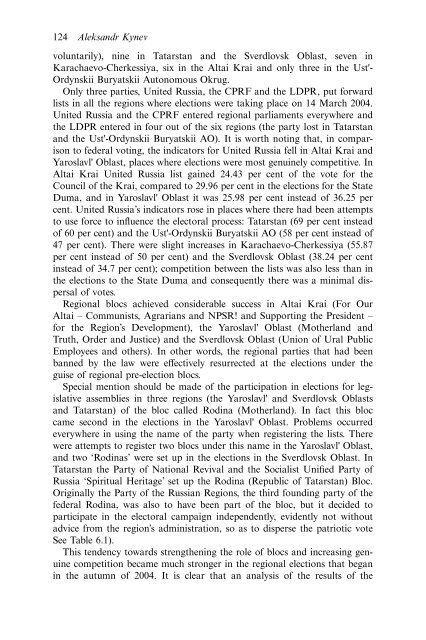Federalism and Local Politics in Russia
Federalism and Local Politics in Russia
Federalism and Local Politics in Russia
You also want an ePaper? Increase the reach of your titles
YUMPU automatically turns print PDFs into web optimized ePapers that Google loves.
124 Aleks<strong>and</strong>r Kynevvoluntarily), n<strong>in</strong>e <strong>in</strong> Tatarstan <strong>and</strong> the Sverdlovsk Oblast, seven <strong>in</strong>Karachaevo-Cherkessiya, six <strong>in</strong> the Altai Krai <strong>and</strong> only three <strong>in</strong> the Ust'-Ordynskii Buryatskii Autonomous Okrug.Only three parties, United <strong>Russia</strong>, the CPRF <strong>and</strong> the LDPR, put forwardlists <strong>in</strong> all the regions where elections were tak<strong>in</strong>g place on 14 March 2004.United <strong>Russia</strong> <strong>and</strong> the CPRF entered regional parliaments everywhere <strong>and</strong>the LDPR entered <strong>in</strong> four out of the six regions (the party lost <strong>in</strong> Tatarstan<strong>and</strong> the Ust'-Ordynskii Buryatskii AO). It is worth not<strong>in</strong>g that, <strong>in</strong> comparisonto federal vot<strong>in</strong>g, the <strong>in</strong>dicators for United <strong>Russia</strong> fell <strong>in</strong> Altai Krai <strong>and</strong>Yaroslavl' Oblast, places where elections were most genu<strong>in</strong>ely competitive. InAltai Krai United <strong>Russia</strong> list ga<strong>in</strong>ed 24.43 per cent of the vote for theCouncil of the Krai, compared to 29.96 per cent <strong>in</strong> the elections for the StateDuma, <strong>and</strong> <strong>in</strong> Yaroslavl' Oblast it was 25.98 per cent <strong>in</strong>stead of 36.25 percent. United <strong>Russia</strong>’s <strong>in</strong>dicators rose <strong>in</strong> places where there had been attemptsto use force to <strong>in</strong>fluence the electoral process: Tatarstan (69 per cent <strong>in</strong>steadof 60 per cent) <strong>and</strong> the Ust'-Ordynskii Buryatskii AO (58 per cent <strong>in</strong>stead of47 per cent). There were slight <strong>in</strong>creases <strong>in</strong> Karachaevo-Cherkessiya (55.87per cent <strong>in</strong>stead of 50 per cent) <strong>and</strong> the Sverdlovsk Oblast (38.24 per cent<strong>in</strong>stead of 34.7 per cent); competition between the lists was also less than <strong>in</strong>the elections to the State Duma <strong>and</strong> consequently there was a m<strong>in</strong>imal dispersalof votes.Regional blocs achieved considerable success <strong>in</strong> Altai Krai (For OurAltai – Communists, Agrarians <strong>and</strong> NPSR! <strong>and</strong> Support<strong>in</strong>g the President –for the Region’s Development), the Yaroslavl' Oblast (Motherl<strong>and</strong> <strong>and</strong>Truth, Order <strong>and</strong> Justice) <strong>and</strong> the Sverdlovsk Oblast (Union of Ural PublicEmployees <strong>and</strong> others). In other words, the regional parties that had beenbanned by the law were effectively resurrected at the elections under theguise of regional pre-election blocs.Special mention should be made of the participation <strong>in</strong> elections for legislativeassemblies <strong>in</strong> three regions (the Yaroslavl' <strong>and</strong> Sverdlovsk Oblasts<strong>and</strong> Tatarstan) of the bloc called Rod<strong>in</strong>a (Motherl<strong>and</strong>). In fact this bloccame second <strong>in</strong> the elections <strong>in</strong> the Yaroslavl' Oblast. Problems occurredeverywhere <strong>in</strong> us<strong>in</strong>g the name of the party when register<strong>in</strong>g the lists. Therewere attempts to register two blocs under this name <strong>in</strong> the Yaroslavl' Oblast,<strong>and</strong> two ‘Rod<strong>in</strong>as’ were set up <strong>in</strong> the elections <strong>in</strong> the Sverdlovsk Oblast. InTatarstan the Party of National Revival <strong>and</strong> the Socialist Unified Party of<strong>Russia</strong> ‘Spiritual Heritage’ set up the Rod<strong>in</strong>a (Republic of Tatarstan) Bloc.Orig<strong>in</strong>ally the Party of the <strong>Russia</strong>n Regions, the third found<strong>in</strong>g party of thefederal Rod<strong>in</strong>a, was also to have been part of the bloc, but it decided toparticipate <strong>in</strong> the electoral campaign <strong>in</strong>dependently, evidently not withoutadvice from the region’s adm<strong>in</strong>istration, so as to disperse the patriotic voteSee Table 6.1).This tendency towards strengthen<strong>in</strong>g the role of blocs <strong>and</strong> <strong>in</strong>creas<strong>in</strong>g genu<strong>in</strong>ecompetition became much stronger <strong>in</strong> the regional elections that began<strong>in</strong> the autumn of 2004. It is clear that an analysis of the results of the
















